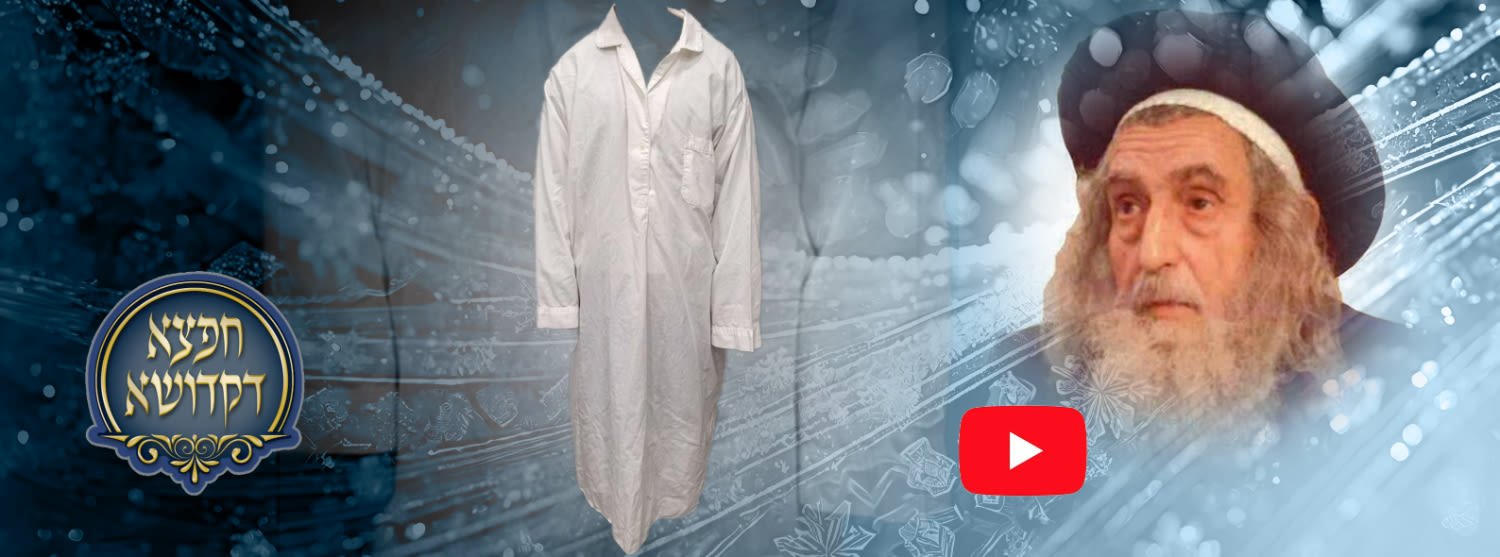
“It says in the Yerushalmi that a person’s garb absorbs his sanctity, and one who wears it after him receives that same spirit for better or worse. This is the secret by which a person’s sons wear them after him.” ( Chatam Sofer al HaTorah parashat Toldot)
Sacred fabric robe that belonged to the great wonder-worker, Rabbi Chaim Zanvl Abramowitz – the Ribnitzer Rebbe, who wore it over a long period directly on his pure body with no barrier [as noted in the attached confirmation]. While wearing it, he would perform his Divine service with his famed wondrous devotion. [Jerusalem-New York, c. 1970].
The robe is made in the Chassidic cut – “right over left” as some Chassidim and Kabbalists are particular to wear [so that right – the sanctity, is increased over the left – the sitra achra ]. We will emphasize that we are not discussing a simple shirt, but a lengthy robe [ rebbishe hemd ] like a long overcoat that one dons by putting it on over one’s head and then closed with two buttons. The robe reaches below the knees. It can be used for levush mal’achim – the sacred kittel , on the high holidays, during Seder night and under the wedding canopy. Chassidim and accomplished people would use sacred clothing from tzaddikei hadorot sacred and auspicious times.
Segulah of Tzaddikim’s belongings: The Chatam Sofer wrote in his sefer ( parashat Toldot): “The Yerushalmi implies in Moed Kattan that a person’s garb is influenced by the sanctity of its wearer, and this is also true in the reverse, so one who wears it after him receives that same spirit for better or worse. This is the secret by which a person’s sons wear them after him.” He received this concept from his teacher, the Ba’al Hafla’ah, who wrote in his work Panim Yafot ( parashat Lech Lecha) as follows: “Tzaddikim’s belongings are enshrouded in sanctity.” This idea is studied and oft repeated by gedolei hadorot in all circles and communities. It is brought in the name of the Ba’al Shem Tov that an item used by a tzaddik has the power to influence the person who has it, and it has the capacity to bring salvation to the one who has it, as follows: “A person’s soul, spirit and neshamah of a person are wrapped … in his belongings, such that parts of his soul are covered in them. There is no greater connection than this.” ( Ketter Shem Tov Part 1, 194). It is told in the name of Rabbi Mordechai of Nezkizh, that he said regarding the vessel given to him by his rabbi, Rabbi Michel of Zlotchov: “This vessel gives the power to perform miracles and wonders …” ( Divrei Binah leaf 47).
So much sanctity and purity, Torah and prayer, wonder and revelation was absorbed by this robe when it was wrapped around the Ribnitzer Rebbe’s sacred body. It was regarding an item exactly like this about which the Rebbe of Nezkizh (in the above-mentioned sefer ) writes: “This vessel has the ability to enact miracles and wonders”!!
Specifications: White fabric robe, large size, reaching under the knees.
Fine condition. Sacred usage marks.
Confirmation included from the rebbe’s personal assistant, Rabbi Ben-Tziyon Adler, attesting that the Rebbe wore this robe over a long period.
Refer to the Hebrew catalog text for a brief biography of the sacred Admo”r Rabbi Chaim Zanvl Abramowitz and a short discussion of the segulah of white clothes to drive away damagers.
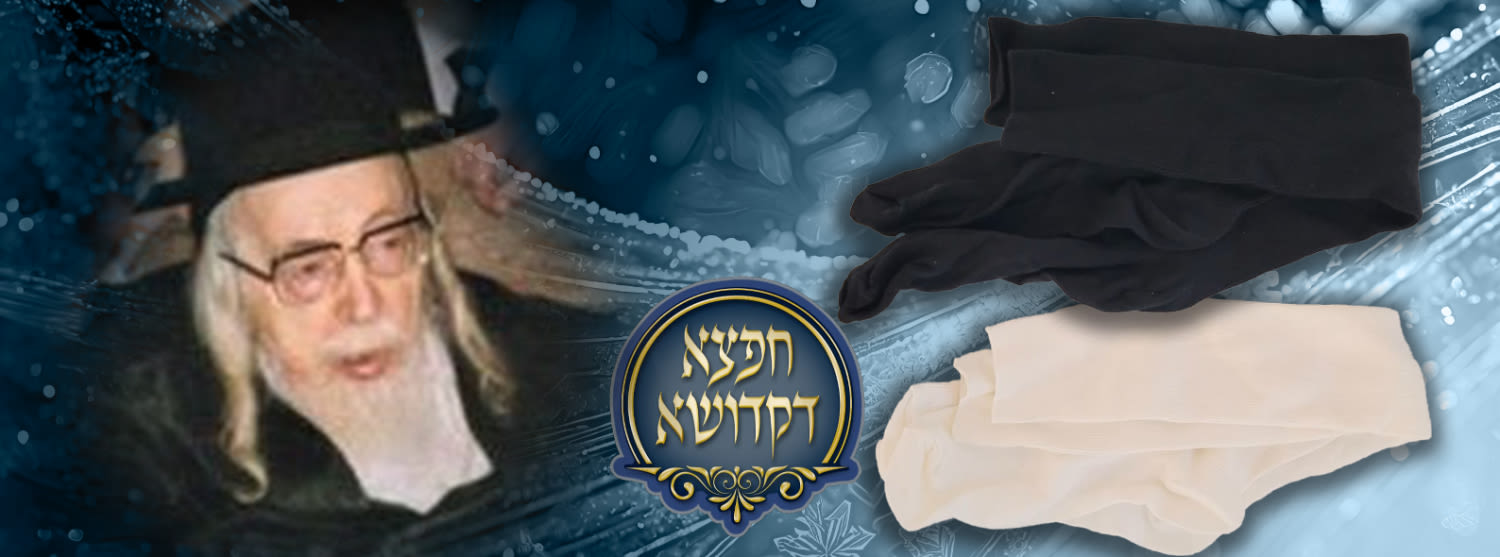
“I will greatly rejoice in G-d for he has clothed me with the garments of salvation, as a bridegroom decks himself with a garland and as a bride adorns herself with her jewels”
2 pairs of socks of the renowned wonder-worker the Admo”r Rabbi Yankeleh of Pshevorsk, one of the leading Admori”m of Europe and one of the most important Admori”m of his generation. Extremely rare pieces of clothing worn by the Rebbe, with nothing intervening.
The pieces include:
* A pair of black socks worn by the Rebbe on the days of the week. On the 21st of Adar (the Hillula of the Rebbe Rabbi Elimelech of Lizhensk) 1997, which that year was on Friday, when the Rebbe changed his clothes for Sabbath, he gave the socks to his devoted meshamesh (as appearing in the enclosed confirmation).
* A pair of white socks – ‘Vaseh Zaken’, which Admori”m wear on Sabbath and Holidays. On Motzaei Chag Shemini Atzeret 1997, the Rebbe gave them to his loyal gabai (as appearing in the enclosed confirmation).
It is known that all items which belonged to tzaddikim are a tried and true Segulah. As elucidated in the book Divrei Torah by the Minchat Eliezer of Munkatch (Mahadura a, letter 22-23): “We have found that the source of the custom of tzaddikim, our rabbis and forefathers, who ascribed importance to items used by tzaddikim and some tzaddikim and chassidim paid a fortune for such items etc. is in the Yerushalmi that an item used by a tzaddik, even if it is an earthly item, can merit knowledge and all kinds of favors of this world”. All the more so these pieces of clothing, which were worn by the tzaddik with nothing intervening, are capable of healing, as brought in the name of Rabbi Moshe of Kosov author of Leket Ani : “All items that come from the possession of a sacred person, if held by an ill person, the external power flees from him, and the patient is healed along the way”.
In various Jewish communities around the world, as an auspicious omen, would wear a kippah that was used by rabbinic leaders at important life occasions (ritual circumcision, redemption of the firstborn and weddings). The kippahs were generally the property of descendants of these tzaddikim or wealthy individual who paid a steep price, and they would graciously lend them to people hosting family celebrations (until various unscrupulous individuals came along desiring to acquire these items for themselves, at which point this lending stopped). The owners of the kippahs themselves would wear them as a segulah on the high holidays – on Rosh HaShanah and on Yom Kippur or when they were ill, as brought in Otzar Yad Hachaim (letter 280): “A pure source among tzaddikim who insist on wearing on Rosh Hashanah and Yom Kippur etc. clothes of past tzaddikim, see Yerushalmi Ta’anit chapter 4 Halachah 1 etc”.
Refer to Hebrew catalog text for a brief biography of Rabbi Yaakov Leiser of Pshevorsk.
Overall condition: Fine.
Enclosed is confirmation signed by the devoted meshamesh of the Rebbe in his last years, Rabbi Shalom Yaakov Yisrael Veyeshurun Kahana, on the authenticity of the items and that they came into his possession in a kosher way, with approval and authority.
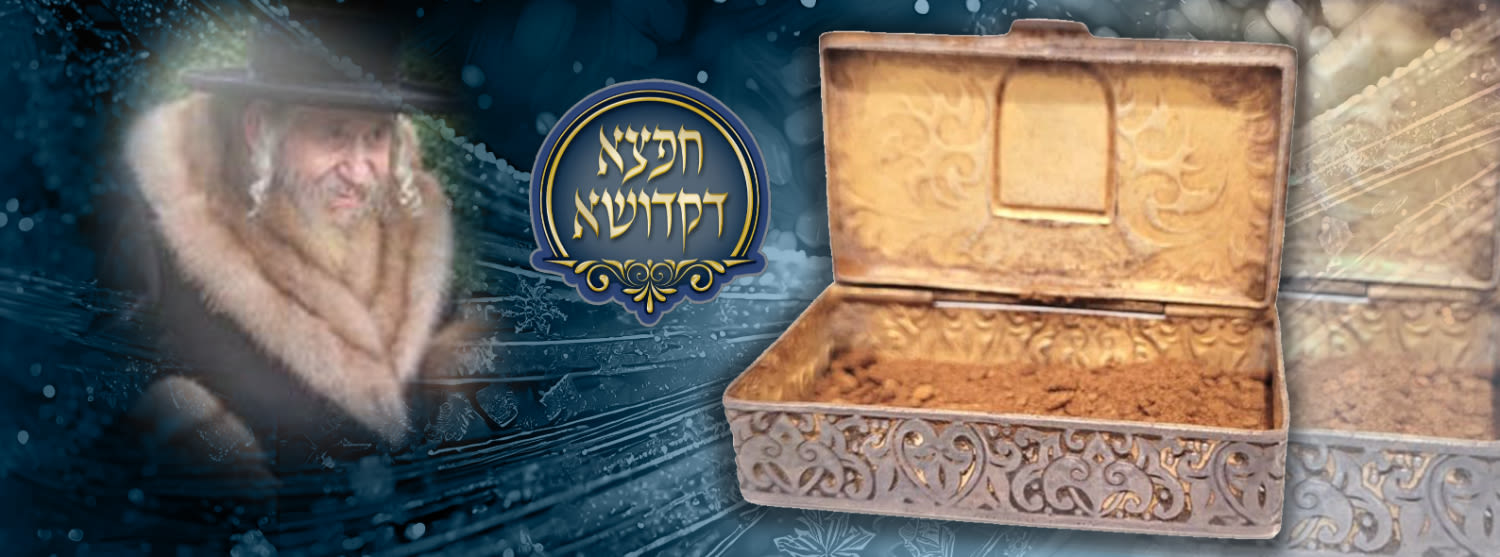
Personal tobacco case that belonged to the pillar of the Jewish people, Rabbi Meshulim Feish Lowey of Tosh. The box is entirely silver, with leftover tobacco from that which was sniffed by the sacred rebbe, and through which he would enact his salvations for one and all. Extraordinarily rare segulah object, only a few like it are known to have been inherited from tzaddikei hadorot like him. Especially wondrous stories are told about them:
Rabbi Yeshayah of Chechnov, son of the Admo”r, the author of Divrei Chayim of Sanz, who inherited his father’s tobacco box, was known to use it to enact wonders [mainly for the childless].
In recent generations as well, the Admo”r R’ Mosheleh of Lelov’s tobacco box, in his grandchildren’s the Bernstein family’s possession, is a known magnet for the ill of Jerusalem. Anyone who felt unwell would sniff from this box and recover.
Even in the previous generation, the previous Admo”r of Vizhintz was known to have had the tobacco box with a bit of tobacco in it from the progenitor of the dynasty. He would sniff from it during prayers of the Yamim Nora’im as a segulah for his prayers to be willingly accepted.
Rectangular silver tobacco case. A matching lid opens on a hinge. Dimensions: 5x3x1 cm.
Fine condition. Usage marks and smelling stains.
Detailed confirmation of the box’s authenticity along with that of the tobacco inside, and that it was used by the Rebbe for a long time.
………………………………………..
Personal belongings of tzaddikim are known to have great segulah value. It is told in the name of Rabbi Mordechai of Nezkizh, that he said regarding the vessel given to him by his rabbi, Rabbi Michel of Zlotchov: “This vessel gives the power to perform miracles and wonders …” ( Divrei Binah leaf 47). The source of the importance of the tzaddik’s personal belongings was brought long ago in the name of the Ba’al Shem Tov, by his grandson, the author of Degel Machaneh Ephraim (in parashat Bo ): “… All that a person has – his slaves, his servants, his livestock and even all his vessels, are all his sparks, belonging to the root of his soul.” Even the Chata”m Sofer writes in parashat Toldot: It can be understood from the Yerushalmi that a person’s garments are infused with the wearer’s sanctity, and he who wears them after him will be infused with the same spirit for the better or otherwise; this is the secret of his sons wearing them after him.” It is brought in the name of the Rebbe R’ Moshe of Kossov, the author of Leket Ani , that “Every item received from the hand of a sacred person, if a person who is ill wears it, the external force flees from him and as a direct result, he recovers.”
All the more so leftover food from tzaddikim that enters the body and becomes part of the person eating it. Leftover tobacco is at a level beyond this, as it is used for sniffing, and not consumed like food. It directly nourishes the soul, as stated by Chaza”l (Tractate Berachot): “What does the soul enjoy? Scent – as it says, ‘The entire soul shall praise Hashem.'” What a tremendous privilege, what a segulah, to hold this box in one’s hands and sniff from it, especially during the prayers of the Yamim Nora’im – on Rosh HaShanah and on Yom Kippur, when Jews would sniff tobacco at synagogue to ease the fast. And any time one requires salvation.
Refer to the Hebrew catalog text for a brief biography of
Rabbi
Meshulim Feish Lowey .
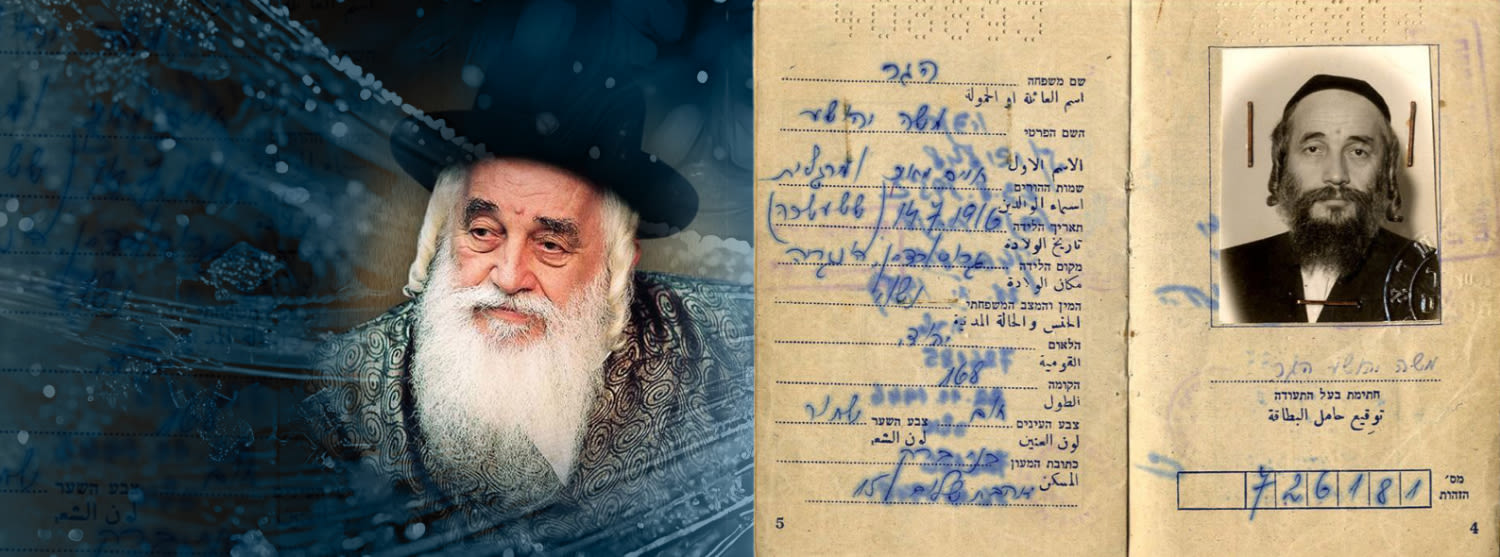
Most sacred – personal papers [ teudat zehut ] of the author of Yeshuot Moshe , the sacred Admo”r Rabbi Moshe Yehoshua Hager of Vizhnitz. [Old-style format, a booklet with a cardboard binding and leaves, similar to passports of our times.] With a passport picture of the Rebbe, and his signature. Ramat Gan, 1961.
One-of-a-kind historic-Chassidic item – ID booklet of one of the most unique tzaddikim of the previous generation, including the Rebbe’s personal details: the place and date of his birth, height, eye color [brown] and hair color [black], along with a list of his children with their birthdates. The list of children includes: his daughter, Rebbetzin Hinda (wife of Rabbi Menachem Ernster), his son Rabbi Menachem Mendel, the Admo”r of Vizhnitz Mercaz shlit”a, Rebbetzin Sarah (the Admo”r of Belz’s wife) and Rebbetzin Sasha (wife of the Admo”r Rabbi Aharon of Satmar). The document does not list the Rebbe’s older sons, nor his daughter the Skverer Rebbetzin, nor his son, Rabbi Yisrael – the Admo”r of Vizhnitz. Apparently only his younger children were recorded in these papers.
Another important historic-Agudist detail that appears here are the stamps for voting for the Knesset and local municipalities. The teudat zehut booklet used to be stamped each time a citizen would exercise his right to vote at a polling station. This booklet bears stamps attesting to the Yeshuot Moshe’s participation in the elections for the fifth Knesset, the seventh, the eighth, the ninth and the tenth Knessets [between 1960 and 1981], along with stamps demonstrating the Yeshuot Moshe’s participation in Bnei Brak’s local elections during this same period. It is interesting to note that there is no stamp attesting to the Vizhnitzer Rebbe’s participation in the sixth Knesset, which took place on 7 Cheshvan 1965. Historians of Vizhnitz Chassidut offer several explanations.
Belongings of tzaddikim carry immense segulah, as attested in Divrei Torah by the Minchat Elazar of Munkacs (first edition, sections 22-23) as follows: “We found that tzaddikim among our rabbis and ancestors considered the items tzaddikim had used significant, and some tzaddikim and Chassidim paid huge amounts for such items, etc. The source for this is the Yerushalmi, which states that an item that was used by a tzaddik, although it is a material item, it yields knowledge, along with all sorts of this-worldly benefits.” It is also brought in the name of Rabbi Moshe of Kossov, author of Lekket Ani , as follows: “Any item that comes from a sacred person, when held by an ill person, causes the external force to flee from him, and as a result, he recovers.” Here is the Rebbe’s most personal official belonging – his identity card, in its most basic meaning.
Refer to the Hebrew catalog text for a brief biography of the Admo”r Rabbi Moshe Yehoshua Hager, author of Yehoshuot Moshe of Vizhnitz .
[1] official booklet, [14] pp. 11×7 cm. Including the Rebbe’s photograph and his signature.
Fine-very fine condition. Official plastic-covered cardboard binding with the State seal.
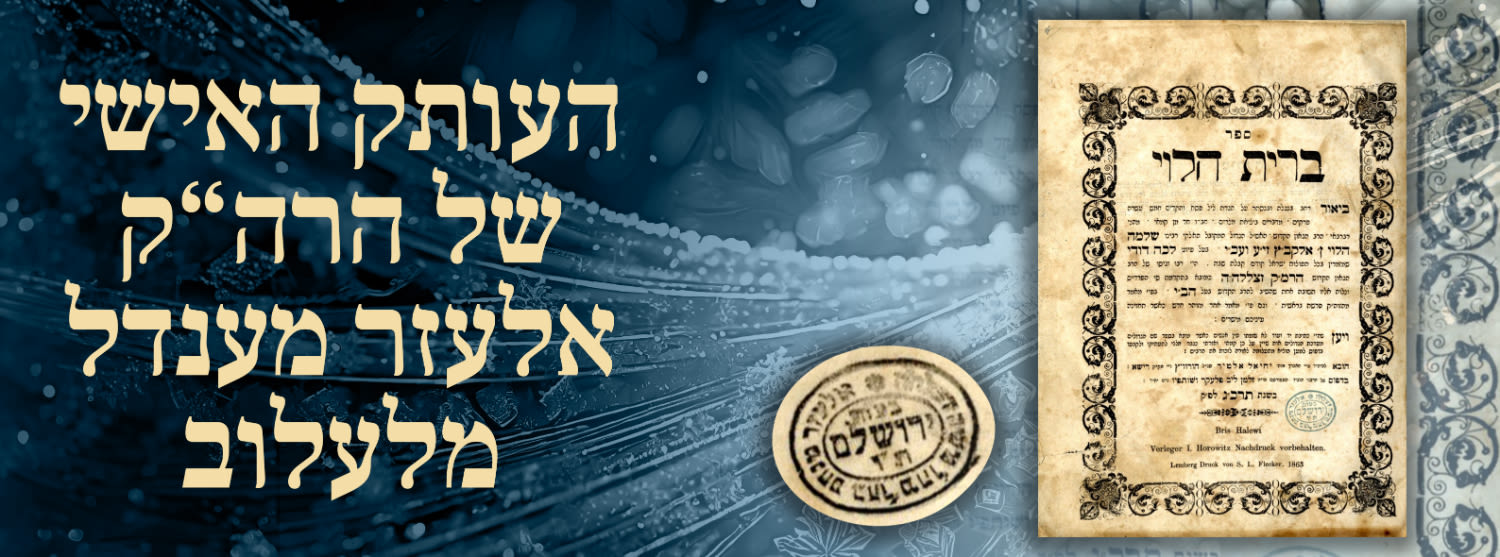
Passover leads all the festivals
Sefer Brit HaLevi , revealed and hidden commentary on the Passover Haggadah by Kabbalist Rabbi Shlomo Alkabetz, author of ‘Lecha Dodi.’ [Lemberg], Zalman Leib Flecker and partners press, 1863. First edition. Personal copy of the third Admo”r of Lelov, Rabbi Elazar Menachem Mendel Biderman, from the period he spent in Jerusalem.
The sefer includes nineteen chapters, including a commentary on the haggadah. Chapters 16-19 include parts of the haggadah text in the center of the leaf, surrounded by the commentary [starting at Ha Lachma Anya through the four questions, Avadim Hayinu , the story of Rabi Elazar ben Azaryah … and Rabi Akiva, who sat together in Bnei Brak – Rabi Elazar Ben Azaryah said, “I am like seventy years old, ” Baruch HaMakom , the four sons – chacham , rasha , tam and eino yode’a lishol , V’Higgadeta L’Vincha , MiTechilah Ovdei Avodah Zarah until ‘And Ya’akov and his sons descended to Egypt’]
The title page and other places feature stamps from the G-dly person, the Admo”r Rabbi Elazar Menachem Mendel Biderman of Lelov, one of the leading Admo”rim of the generations, and leading Admo”r in the Land of Israel. Text of the stamp: “Elazar Menachem Bha’ Mhr’ Moshe ztzllh”h.” This sacred Kabbalistic work was used by Rabbi Elazar Mendel for his sacred service in his home opposite the Temple Mount, and the sacred night of the Passover holiday – the loftiest night of the year, with the most tremendous revelations to Chassidic tzaddikim ! It is chilling to see the multiple stains from spills all along the length of the sefer , characteristic of haggadahs, remnants from this G-dly person’s seder table.
The severe stringencies maintained by the Lelov dynasty for seder night are well-known. They even used special dishes and clothes – and even a special apartment for Passover. There is a famous story about one first night of Passover when a Chassid came to Rabbi Elazar Mendel’s home and pleaded with him to beg for mercy for his wife who had become critically ill. Rabbi Elazar Mendel asked “Is it possible there is still chametz in your home?” The man went back home and checked all the nooks and crannies, yet did not find even one crumb of chametz. He returned to his rebbe in disappointment. The rebbe said – go look in such-and-such a sefer that you studied on Shabbat while you were eating kugel – perhaps a single noodle remains there. The man returned home and checked the sefer , where, much to his astonishment, he found the single noodle the Rebbe mentioned. He immediately destroyed it and ran up to his wife, who had recovered. This demonstrates that the signs of use and the spills in the sefer must be from the Seder night itself and would not have been used after Pesach.
It is important to note the words of the author of Divrei Chaim of Sanz here about Rabbi Elazar Mendel of Lelov’s seder night: “We observed in the upper worlds that the most beautiful seder of all the tzaddikim was the one held by Rabbi Elazar Mendel of Jerusalem.”
Refer to the Hebrew catalog text for a brief biography of Rabbi Elazar Menachem Mendel Biderman of Lelov .
[2], 44 leaf. 25 cm. The stamps are on the title page, leaf 21, and the front protective leaf. Page 2b bears his son’s beautiful stamp – the sacred Rabbi Yerachmiel Yosef, who inherited this sefer from his sacred father.
Overall fine condition. Many sacred stains and usage marks. Tears in both of the first leaves. Small tears in several more leaves. Antique binding, minimally worn and chafed. The front board is partially detached.
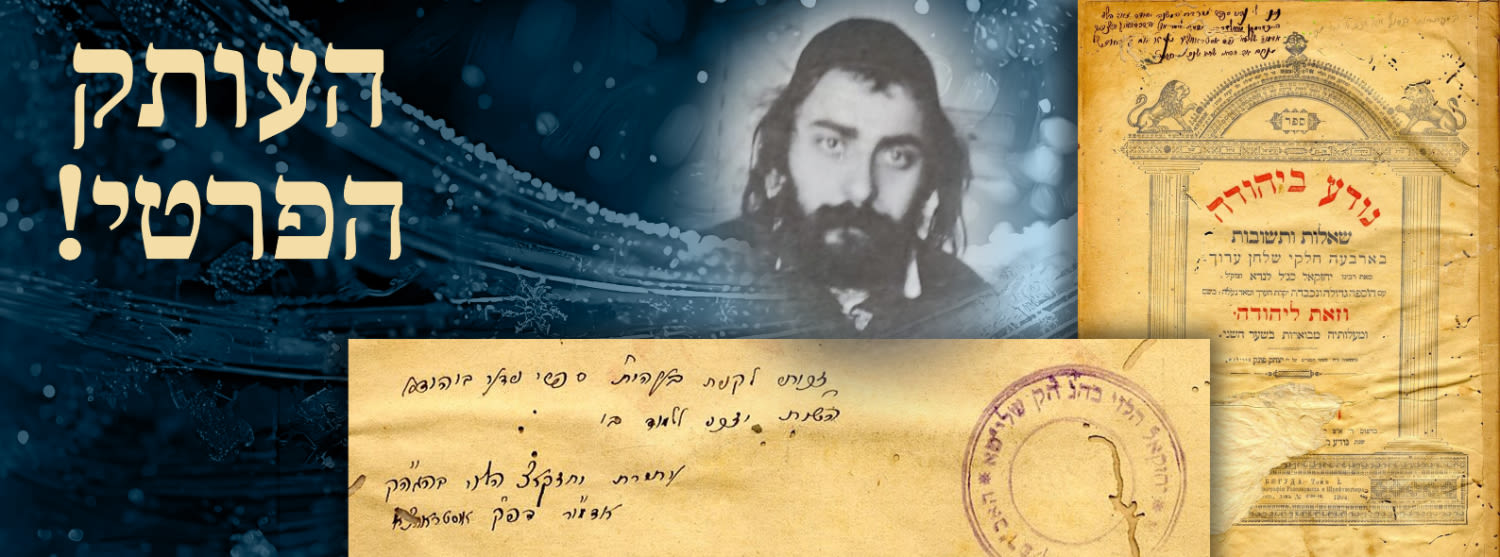
Noda BiYehudah – responsa by Rabbi Yechezkel Landau on the four parts of Shulchan Aruch. Mahadura Kamma . Vilna, 1904.
This sefer belonged to the Admo”r, the sacred gaon Rabbi Yechezkel HaLevi Halstock of Ostrovtza, it also contains his handwritten Torah novellae.
Inscriptions on the back of the frontispiece and on the title page indicate that this sefer belonged to him. With his stamps. “I was privileged to purchase Sefer Noda BiYehuda ; may Hashem grant me the privilege of studying it. This is the prayer of Yechezkel HaLevi, son of the sacred gaon, the Admo”r here in Ostrovtza.
Page 8b (in the first part) bears a lengthy inscription in his hand, which is actually a lengthy passage of Torah insights.
Refer to the Hebrew catalog text for a brief biography of Rabbi Yechezkel HaLevi of Ostrovtza .
Moderate condition. Tears with lack in the text in the first five leaves. Worming perforations. Simple binding.
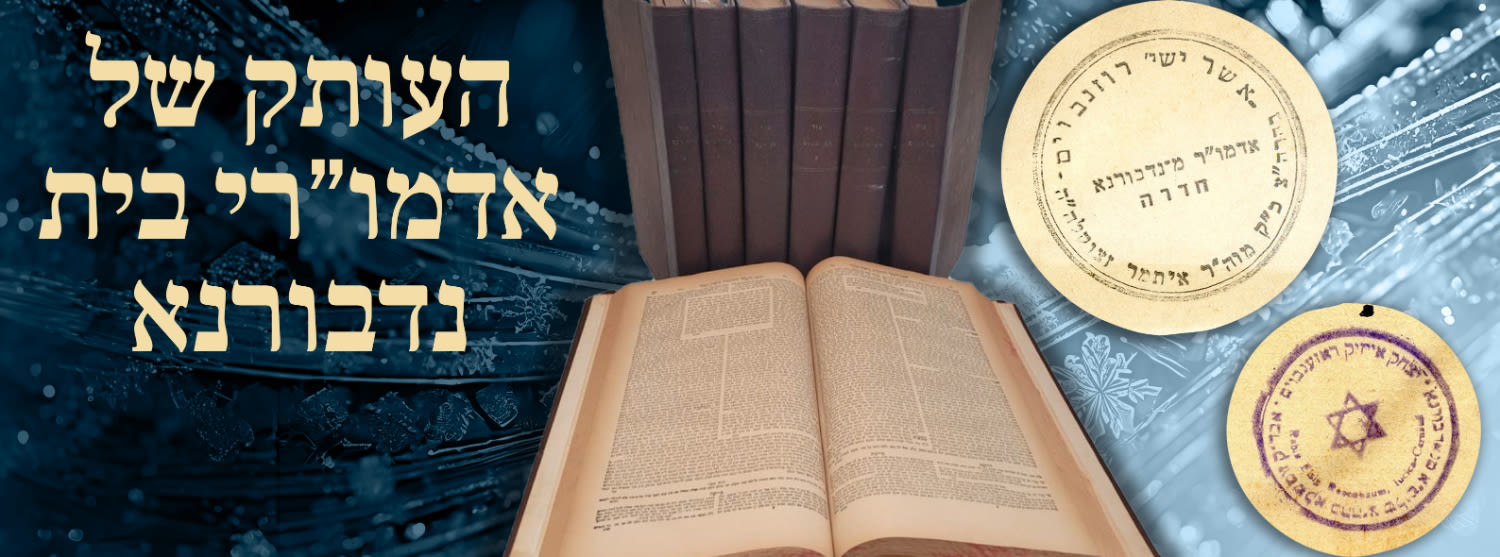
Complete set of Arba’ah Turim with all the commentaries, in large format. Vilna, 1900.
This set had belonged to the Admo”r Rabbi Yitzchak Isaac Rosenbaum of Zutchka and the Admo”r Rabbi Asher Rosenbaum of Nadvorna-Chadera.
These volumes bear two types of stamps from the Admo”r of Zutchka, from when he lived in Zutchka, Romania. ‘Yitzchak Isaac Rosenbaum av beit din of Zutchka, son of the tzaddik of Nadvorna. With two types of stamps from the Admo”r of Nadvorna Chadera “Asher Rosenbaum son of the tzaddik of Nadvorna, ” and from when he resided in Chadera.
The two Admo”rim were brothers, and the Admo”r Rabbi Asher of Nadvorna Chadera was his brother’s, the Admo”r of Zutchka’s, son-in-law.
Refer to the Hebrew catalog text for a brief biography of the sacred gaon Rabbi Yitzchak Isaac Rosenbaum .
Handwritten corrections and glosses by the Admo”r of Zutchka along the leaves of the sefer .
7 volumes, 36.5 cm.
Fine condition. Original bindings.
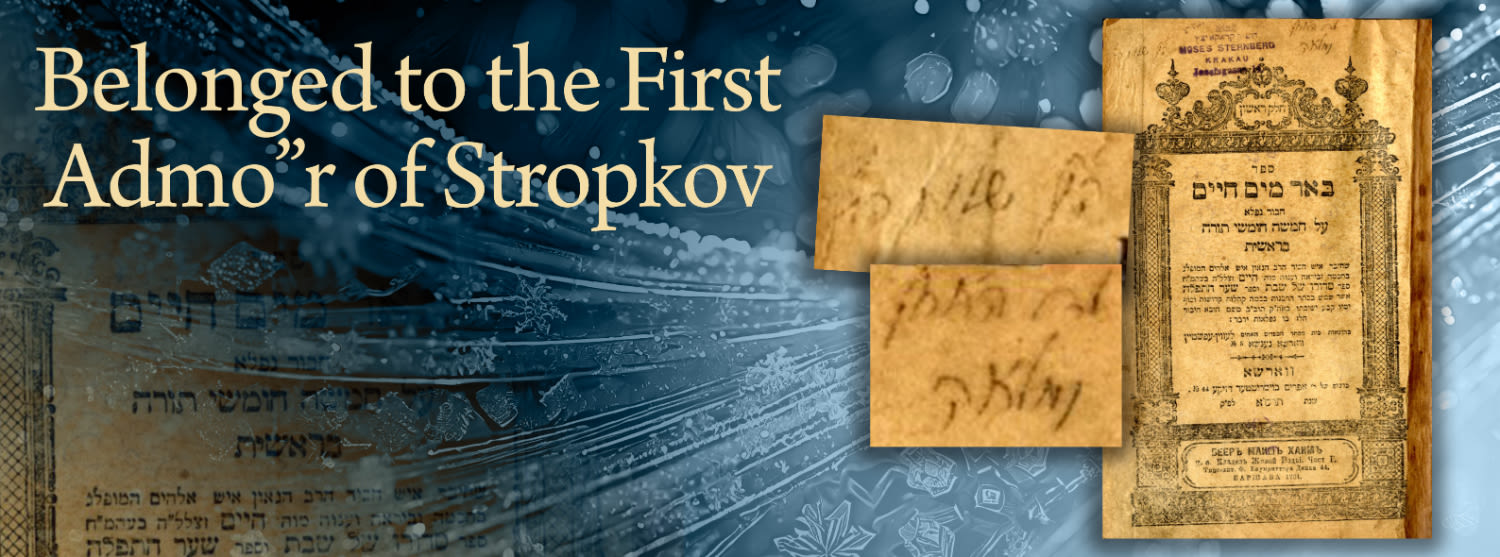
Sefer Be’er Mayim Chayim is one of the most important and renowned sefarim of Chassidut. It was authored by the sacred Admo”r Rabbi Chaim Tirer of Chernowitz, one of the leading Admo”rim of all generations, known by the name of his sefer , Be’er Mayim Chayim . Warsaw, Ephraim Baumritter Press, 1901. Personal copy that belonged to the renowned wonder-worker, ‘Redeemer of the Childless, ‘ the sacred Rabbi Shalom Halberstam of Stropkov, son of the sacred Rebbe Rabbi Yechezkel Shraga of Shinova, son of the Divrei Chaim of Sanz – leading Admo”r of Galicia.
The title page bears the Admo”r of Stropkov’s signature, ” LaHashem HaAretz U’Meloah, HaK’ Shalom Halber[stam]. ” The following leaf bears another handwritten ownership notation: “Belongs to [many honorifics] the pure rabbi and tzaddik shlit”a, av beit din of Stropkov.”
This sacred copy expresses its sanctity in many ways – it belonged to the famous redeemer of the childless; it is covered across its entire length with sacred usage marks (certainly from the Admo”r of Stropkov, and not from the Chassidim who received it after his passing, as they surely preserved it very carefully). It is touching to see this in parashiyot Lech Lecha – Vayera which discuss Hashem’s promises to Avraham Avinu for children. At Yitzchak Avinu’s birth, there are indeed many usage marks that are quite substantial (refer to the photocopy). Who can understand the secrets of the sacred?
The Sanz dynasty attributes tremendous importance to the sefer Be’er Mayim Chayim . The Divrei Chaim would say “It makes the heart flutter to the living Creator.” His son, the Divrei Yechezkel once said that the sefer Be’er Mayim Chayim al HaTorah did good things for his soul.”
The title page also bears the stamp of Rabbi Moshe Sternberg of Kraków, who received permission from the aforementioned Admo”r of Stropkov to reprint Sefer Zevach HaShlamim by Rabbi Moshe Galanti (Podgórze, 1903). He also received permission from the Admo”r’s father, the author of Divrei Yechezkel , for another edition, printed in 1898. Additional stamps: “HaK’ Yosha Yitzchak Burger of Kashau” The Admo”r was known to have lived later in his life in Kashau, and he passed away there.
Refer to the Hebrew catalog text for brief biographies of the Admo”r Rabbi Avraham Shalom Halberstam of Stropkov and Rabbi Moshe Sternberg.
Multiple handwritten notations on the protective leaves.
[1], 199; [1], 200-339, 341-426 leaf. 22 cm. Original semi-leather binding? Embossed.
Fine condition. Stickers for reinforcement on several leaves, light tears in the margins and centers of leaves (some with light damage to the text). Tiny worming perforations. Stains and usage marks. Reinforcements in the margins of the title page, without damage to the text.
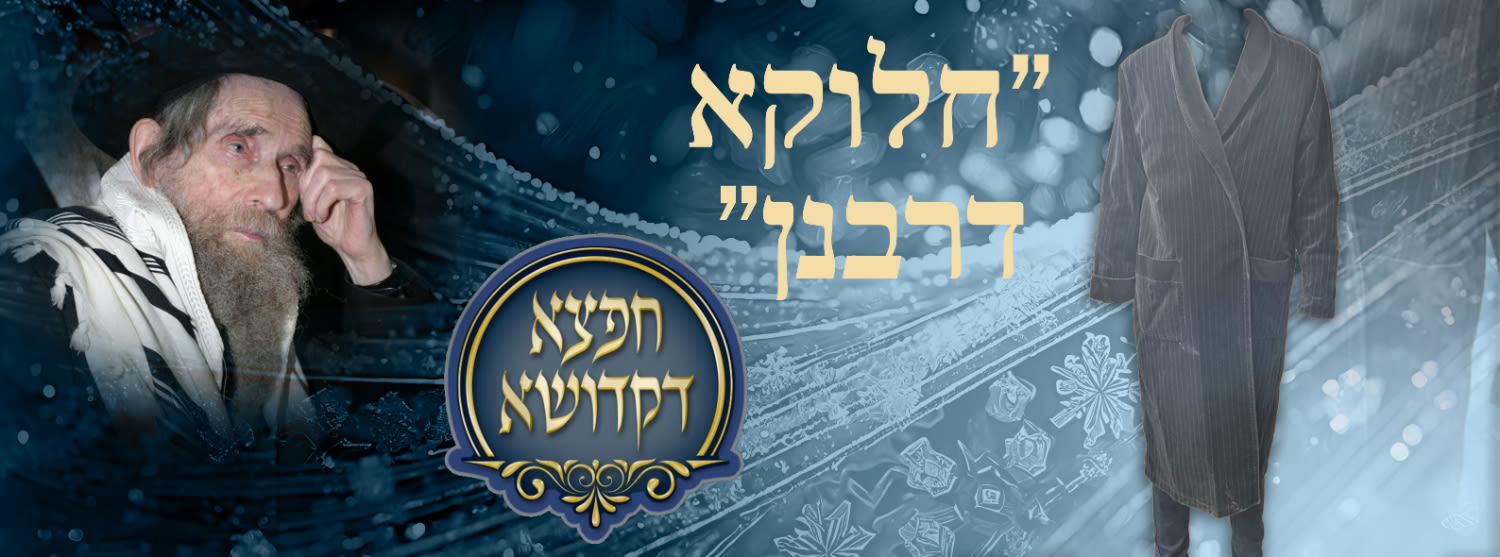
“It says in the Yerushalmi that a person’s garb absorbs his sanctity, and one who wears it after him receives that same spirit for better or worse” (Chatam Sofer on parashat Toldot)
the gadol hador Rabbi Aharon Yehudah Leib Shteinman’s personal velvet robe. Elegant and luxurious robe made of a black velvety textured weave with a delicate striped pattern. Manufactured by the Charles Goodnight company. Important sacred item of one of the most unique righteous geonim of recent generations. “King David was old, advanced in age, and they covered him with garments” (I Melachim 1:1)-.
Direct testimony to the auction house from a beloved grandson and close associate of the gaon Rabbi Aharon Yehudah Leib Shteinman, the gaon Rabbi … [one of the famed geonim of Bnei Brak, whose name is available from the auction house, which can be reached by calling the office, 02-5385670]. He attended to Rabbi Shteinman in his final years, and attests primarily to three things, having witnessed them with his own eyes over the years, and not just from hearing about it:
* Rabbi Aharon Leib gave him this robe personaly and he would wear it primarily during the winter for mant years. [The robe is made of a special fabric which was especially warm. This was necessary for the rabbi due to so many years of self-denial.]
* Rabbi Aharon Leib would be particular to wear this beautiful robe over the course of Shabbat and holidays.
* This robe was used by Rabbi Shteinman for many years.
Rare sacred item with value almost impossible to overstate – personal ” chaluka d’rabbanan ” that belonged to the leader of the previous generation, and which he wore in the last years of his life, when he reached the climax of his spiritual height, and led the entire Jewish people. As the Chatam Sofer stated: “One who wears it after him receives that same spirit for better or worse. This is the secret by which a person’s sons wear it after him”!
The segulah of tzaddikim’s belongings have always been known amongst the Jewish people.
The midrash (Shir HaShirim Rabbah Parashah 1, on the passuk “L’reiach shmenecha tovim”) says “Rabbi Eliezer’s study hall was shaped like an eyelash. One stone was there, designated as his seat. Once Rabbi Yehoshua entered and began to kiss this stone, saying that it is like Mount Sinai, and the one who sat on it is like the ark of the covenant.”
The Yerushalmi (Moed Kattan 3:5b) states: “He had Rabbi Meir’s rod in his hand, and it taught him wisdom.”
The Chatam Sofer ( parashat Toldot, HaLo …) explains: “The Yerushalmi implies at the beginning of Perek V’Eilu Megalchin that a person’s garb is influenced by the sanctity of its wearer, and this is also true in the reverse, so one who wears it after him receives that same spirit for better or worse. This is the secret by which a person’s sons wear them after him.”
The Ba’al Hafla’ah, in his work Panim Yafot (Bereishit 14:22) writes as follows: “And also to the contrary, property of tzaddikim, had spiritual inspiration upon it, as we found in Dor HaMidbar , about whom it is written that their clothes did not wear out, etc.”
The Munkatcher Rebbe (In his sefer , Divrei Torah LaGaha”k MiMunkacs , 1:22) writes that an item that was used by a tzaddik, even a material item, has the ability to grant wisdom, how much more so the benefits of this world …
Refer to the Hebrew catalog text for a brief biography of the gaon Rabbi Aharon Yehudah Leib Shteinman .
Fine-very fine condition. Usage marks.
The proceeds from the sale of the item are intended for the support of Torah!
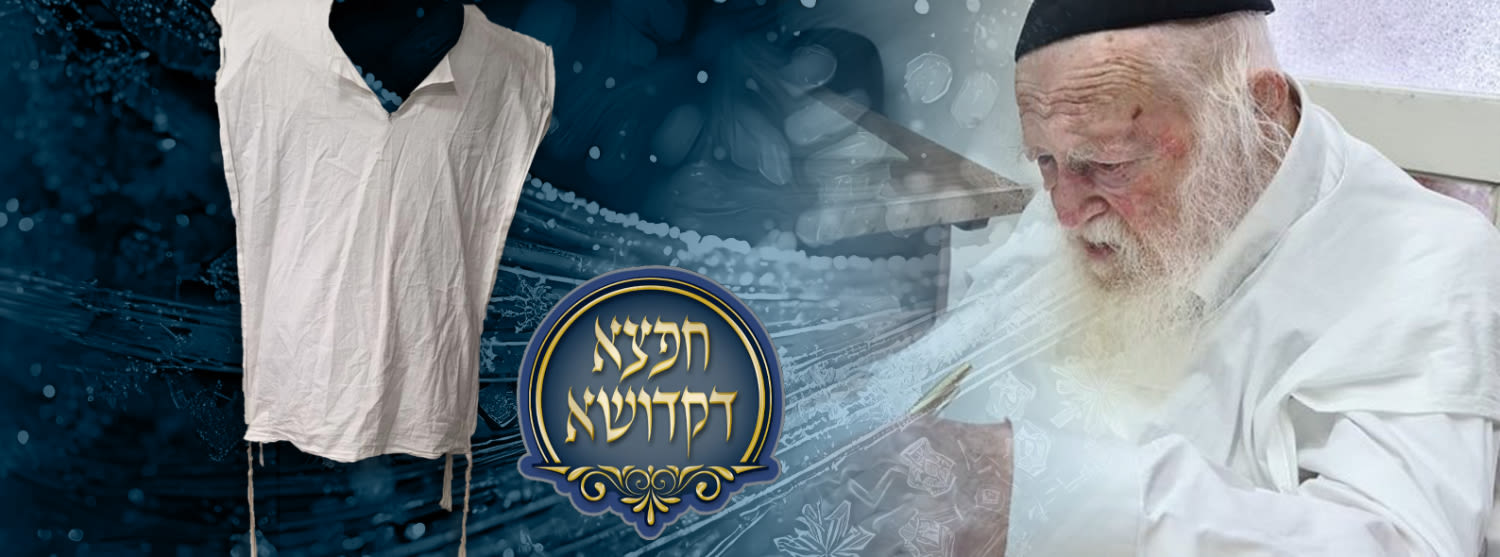
“The tallit will spread its wings over them and save them, as an eagle awakens its nest, hovering over its chicks”
Cotton tallit-kattan worn for years by the Sar HaTorah, Rabbi Chaim Kanievsky, and upon which he recited the blessings on a daily basis.
The seller received the tzitzit from Rebbetzin Kanievsky many years ago. It has been checked and found to be kosher (for blessing).
This tallit kattan is from the Sar HaTorah’s early years. It is made from high-quality cotton, unlike the fabric of current tzitzit. The fabric is totally plain, with no pattern, not even in the fabric itself. The fabric does show many years’ worth of Reb Chaim’s use, and he undoubtedly completed Sha”s more than once while wearing this tallit kattan. The strings of the tzitzit also show signs of use, having been kissed by the gaon Rabbi Chaim on a daily basis over several years!
The immense segulah of tzitzit is renowned aside from the mitzvah d’orayta we mention three times a day in kriyat shema . The Vilna gaon observed before he left this world – their reward is invaluable. Tzitzit in general, and how much more so the tallit kattan that belonged to one of the leading tzaddikim, comprises a heavenly protection from damagers and is also a segulah to find one’s spouse. As stated in Kitvei HeAr”i ( Pri Etz Chaim , Sha’ar HaTzitzit, Chapter 2). “The inyan of the four tzitzit, all of which derive from the yessod called tzaddik elyon … is well-known, as a woman does not seal a covenant with one who has not made himself a vessel …” Rabbi Aharon Leib Shteinman states in Ayelet HaShachar ( Sefer Bereishit , p. 90): “The mitzvah of tzitzit is weighted like the 613 mitzvahs, and Yefet earned the merit of being buried by his sons in the war of Gog U’Magog … the mitzvah of tzitzit is forever, and anyone who does it, it is as if he has performed all 613 mitzvahs. ”
The segulah power of items that were used by tzaddikim are known to Jews from time immemorial, as stated in Talmud Yerushalmi, ( Moed Kattan 3:5a) “He had Rabbi Meir’s rod in his hand, and it taught him wisdom.” The Chata”m Sofer ( Parashat Toldot , “HaLo …”) writes about the clothing of tzaddikim: “The Yerushalmi implies at the beginning of Perek V’Eilu Megalchim , that a person’s clothing absorbs sanctity from its wearer. The reverse is also true, in that one who wears the clothes after the tzaddik receives that same spirit for better or worse. This is the secret by which a person’s sons wear them after him.” The author of Hafla’ah , in his sefer Panim Yafot , (Bereishit 14:22) writes as follows: “It also works in reverse for tzaddikim’s belongings, in that the spirit of sanctity hovers over them, as we find in Dor HaMidbar regarding whom it mentions “your clothes did not wear out …” The author of Minchat Elazar of Munkacs writes in his sefer Divrei Torah (first edition, section 22) “An object used by a tzaddik, even a material one, grants knowledge, and all the more so, all sorts of this-worldly benefits.”
Confirmation included from the seller regarding receipt of the tallit kattan.
Magnificent tallit kattan with tzitzit, kosher. 144×68 cm (large shiur ). One perforation in each corner, with the original tzitziyot.
Usage marks. Small tear in the neck opening. The tallit is in very fine condition, the tzitziyot are in used condition. One of them is short.
The proceeds from the sale of the item are intended for the support of Torah!
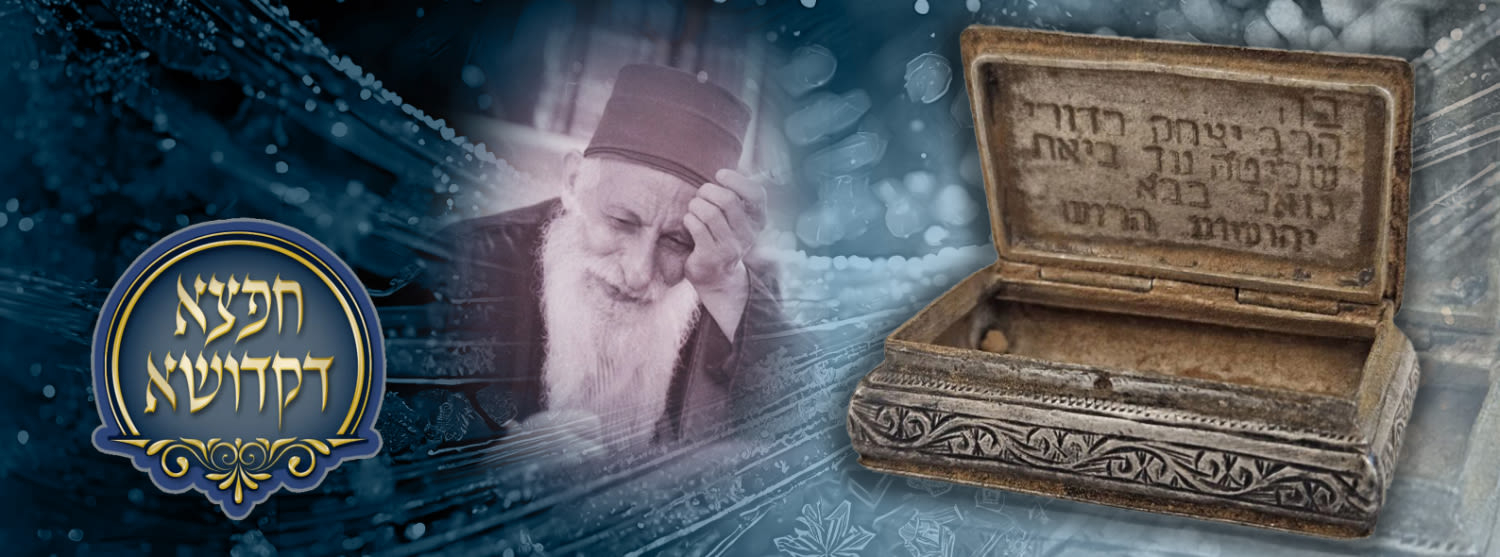
“ב”ה הרב יצחק כדורי שליט”ה עד ביאת גואל בב”א”
Personal tobacco box previously owned by the leading Kabbalist of the most recent generation, Chacham Yitzchak Kadouri, made entirely of pure stamped silver. With remnants of the original tobacco Rabbi Kadouri sniffed per Kabbalistic kavvanot and through which he enacted salvation for one and all. The box and the tobbaco in it were inherited by his only son, Rabbi David Kadouri, as attested in the attached confirmation [see below], both the tobacco inside and the original authorization included by his only son and successor.
All items owned by tzaddikim have segulah capabilities, as is well-known. How much more so remnants of food that tzaddikim put in their bodies and which became part of the person who consumed them. Beyond even this is remnants of tobacco that was only sniffed, not consumed like food, as it directly nourishes the soul, as Chaza”l say (Tractate Berachot): “What does a soul derive pleasure from? Smell, as it says, ‘ kol haneshamah tehallel ya-h ‘.” Unique item second to none, with the power – according to tradition described below – to enact miracles like its owner – the G-dly Kabbalist Chacham Yitzchak Kadouri!
This sacred tobacco box was constantly at Rabbi Kadouri’s side, every moment he performed his sacred Divine service, whether while studying concealed Kabbalah, when he would draw the tobacco close and rise up to lofty heights, or while he received the public for whom he would enact supernatural wonders for the Jewish people. He would occasionally hold this box in his sacred hands and sniff the tobacco – “l’rei’ach nichoach isheh laHashem.” What a huge privilege and tremendous segulah to hold this box in one’s hands and sniff from it, especially during the prayers of the high holidays, on Rosh HaShanah and on Yom Kippur, when Jews have the custom to smell tobacco in the synagogue to ease the fast.
Leading Kabbalists and Admo”rim would achieve the most wonderful heights while sniffing tobacco. Kitvei HeAr”i designates an entire chapter to Kabbalistic kavvanot to have while sniffing, intentions that come from the passuk ” l’rei’ach nichoach isheh laHashem .” It is also well-known that the Baba Sali, whose grandfather was the Abir Ya’akov, said that had all the kavvanot HeAr”i in mind when he sniffed tobacco. Chassidic leaders also knew the power of sniffing tobacco. The rebbi Rabbi Yeshayah of Chechov, son of the Admo”r, author of Divrei Chaim of Sanz, inherited his father’s box and used it to enact wonders. Even in recent generations, there was Rabbi Moshe of Lelov’s famed tobacco box, which was in his grandsons’ possession – the Bernstein family. It is a magnet for the ill in Jerusalem. Anyone who felt unwell would take a sniff from it and recover. Even in the preceding generation, it was known that the previous Admo”r of Vizhnitz had a tobacco box with a small amount of tobacco in it from the progenitor of the dynasty, and he would sniff from it during high holiday prayers as a segulah for his prayers to be graciously accepted.
This tobacco box is also unique in that it has explicit, written and signed tradition. The box was inherited by the sole heir, Rabbi Kadouri’s beloved son Rabbi David, who also succeeded his father upon the latter’s passing. He left a signed confirmation on a picture of the tobacco box for its positive identification in subsequent generations, stating as follows: “I hereby attest that the tobacco box in the photograph on the reverse side of this leaf was used consistently (!) by my father and teacher, the senior Kabbalist Rabbi Yitzchak Kadouri ztzukllh”h . Sincerely, David Kadouri.”
Refer to the Hebrew catalog text for brief biographies of the elder Kabbalist Rabbi Yitzchak Kadouri and his son, Kabbalist Rabbi David Kadouri .
Rectangular tobacco box made of silver stamped Israel 925. Matching hinged lid. 5x3x1 cm.
Fine condition. Many years’ usage marks.